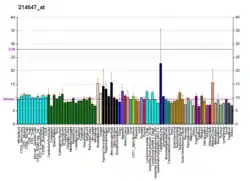ADCY10
Adenylyl cyclase 10 also known as ADCY10 is an enzyme that, in humans, is encoded by the ADCY10 gene.[5]
Function
The protein encoded by this gene belongs to a distinct class of mammalian adenylyl cyclase that is soluble and insensitive to G protein or forskolin regulation. It is localized in the cytoplasm and is thought to function as a general bicarbonate sensor throughout the body. It may also play an important role in the generation of cAMP in spermatozoa, implying possible roles in sperm maturation through the epididymis, capacitation, hypermotility, and/or the acrosome reaction.[6]
Clinical significance
Mutations in the ADCY10 gene are associated with an increased risk of adsorptive hypercalciuria.[5]
References
- GRCh38: Ensembl release 89: ENSG00000143199 - Ensembl, May 2017
- GRCm38: Ensembl release 89: ENSMUSG00000026567 - Ensembl, May 2017
- "Human PubMed Reference:". National Center for Biotechnology Information, U.S. National Library of Medicine.
- "Mouse PubMed Reference:". National Center for Biotechnology Information, U.S. National Library of Medicine.
- Reed BY, Heller HJ, Gitomer WL, Pak CY (November 1999). "Mapping a gene defect in absorptive hypercalciuria to chromosome 1q23.3-q24". J. Clin. Endocrinol. Metab. 84 (11): 3907–13. doi:10.1210/jc.84.11.3907. PMID 10566627.
- "Entrez Gene: ADCY10".
External links
- Human ADCY10 genome location and ADCY10 gene details page in the UCSC Genome Browser.
Further reading
- Wuttke MS, Buck J, Levin LR (2002). "Bicarbonate-regulated soluble adenylyl cyclase". JOP. 2 (4 Suppl): 154–8. PMID 11875252.
- Hukovic N, Panetta R, Kumar U, et al. (1998). "The cytoplasmic tail of the human somatostatin receptor type 5 is crucial for interaction with adenylyl cyclase and in mediating desensitization and internalization". J. Biol. Chem. 273 (33): 21416–22. doi:10.1074/jbc.273.33.21416. PMID 9694905.
- Buck J, Sinclair ML, Schapal L, et al. (1999). "Cytosolic adenylyl cyclase defines a unique signaling molecule in mammals". Proc. Natl. Acad. Sci. U.S.A. 96 (1): 79–84. doi:10.1073/pnas.96.1.79. PMC 15096. PMID 9874775.
- Hayes JS, Lawler OA, Walsh MT, Kinsella BT (1999). "The prostacyclin receptor is isoprenylated. Isoprenylation is required for efficient receptor-effector coupling". J. Biol. Chem. 274 (34): 23707–18. doi:10.1074/jbc.274.34.23707. PMID 10446129.
- Sinclair ML, Wang XY, Mattia M, et al. (2000). "Specific expression of soluble adenylyl cyclase in male germ cells". Mol. Reprod. Dev. 56 (1): 6–11. doi:10.1002/(SICI)1098-2795(200005)56:1<6::AID-MRD2>3.0.CO;2-M. PMID 10737962.
- Chen Y, Cann MJ, Litvin TN, et al. (2000). "Soluble adenylyl cyclase as an evolutionarily conserved bicarbonate sensor". Science. 289 (5479): 625–8. doi:10.1126/science.289.5479.625. PMID 10915626.
- Jaiswal BS, Conti M (2001). "Identification and functional analysis of splice variants of the germ cell soluble adenylyl cyclase". J. Biol. Chem. 276 (34): 31698–708. doi:10.1074/jbc.M011698200. PMID 11423534.
- Reed BY, Gitomer WL, Heller HJ, et al. (2002). "Identification and characterization of a gene with base substitutions associated with the absorptive hypercalciuria phenotype and low spinal bone density". J. Clin. Endocrinol. Metab. 87 (4): 1476–85. doi:10.1210/jc.87.4.1476. PMID 11932268.
- Zippin JH, Chen Y, Nahirney P, et al. (2003). "Compartmentalization of bicarbonate-sensitive adenylyl cyclase in distinct signaling microdomains". FASEB J. 17 (1): 82–4. doi:10.1096/fj.02-0598fje. PMID 12475901.
- Strausberg RL, Feingold EA, Grouse LH, et al. (2003). "Generation and initial analysis of more than 15,000 full-length human and mouse cDNA sequences". Proc. Natl. Acad. Sci. U.S.A. 99 (26): 16899–903. doi:10.1073/pnas.242603899. PMC 139241. PMID 12477932.
- Litvin TN, Kamenetsky M, Zarifyan A, et al. (2003). "Kinetic properties of "soluble" adenylyl cyclase. Synergism between calcium and bicarbonate". J. Biol. Chem. 278 (18): 15922–6. doi:10.1074/jbc.M212475200. PMID 12609998.
- Jaiswal BS, Conti M (2003). "Calcium regulation of the soluble adenylyl cyclase expressed in mammalian spermatozoa". Proc. Natl. Acad. Sci. U.S.A. 100 (19): 10676–81. doi:10.1073/pnas.1831008100. PMC 196863. PMID 12958208.
- Marjanovic JA, Li Z, Stojanovic A, Du X (2006). "Stimulatory roles of nitric-oxide synthase 3 and guanylyl cyclase in platelet activation". J. Biol. Chem. 280 (45): 37430–8. doi:10.1074/jbc.M506518200. PMID 16144836.
- Schmid A, Sutto Z, Nlend MC, et al. (2007). "Soluble Adenylyl Cyclase Is Localized to Cilia and Contributes to Ciliary Beat Frequency Regulation via Production of cAMP". J. Gen. Physiol. 130 (1): 99–109. doi:10.1085/jgp.200709784. PMC 2154360. PMID 17591988.
This article incorporates text from the United States National Library of Medicine, which is in the public domain.





